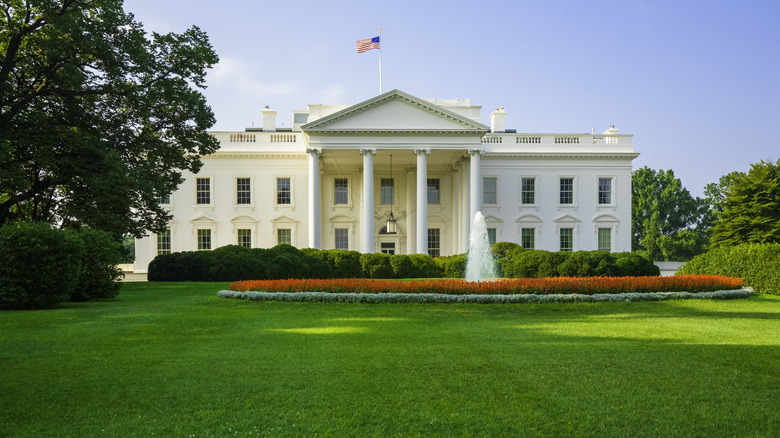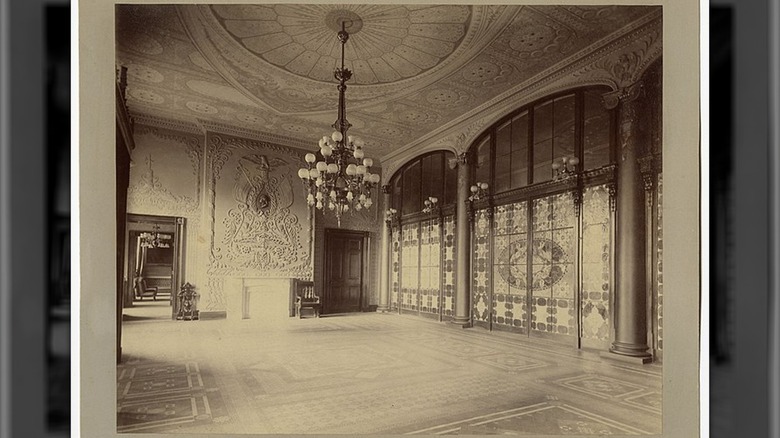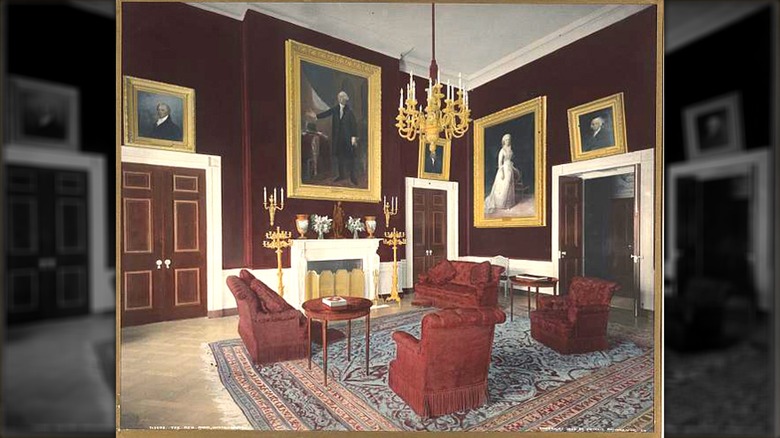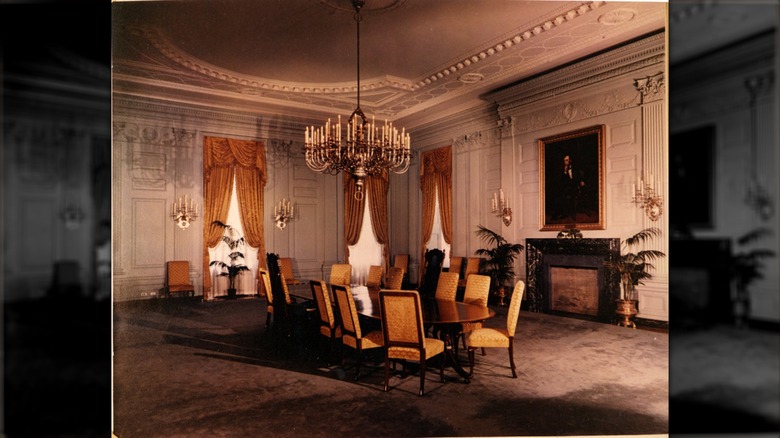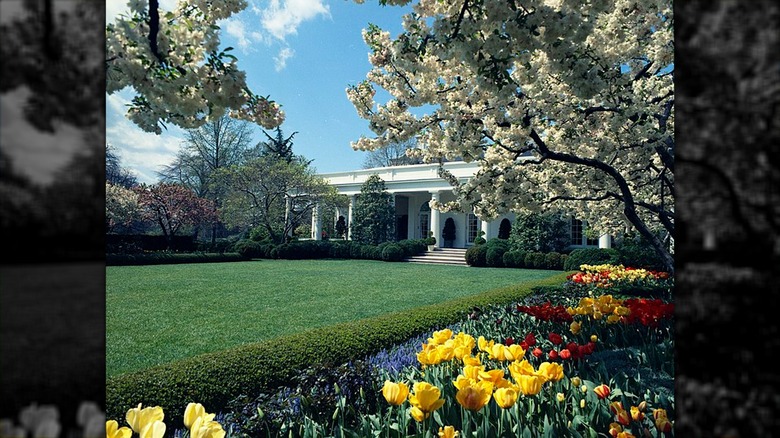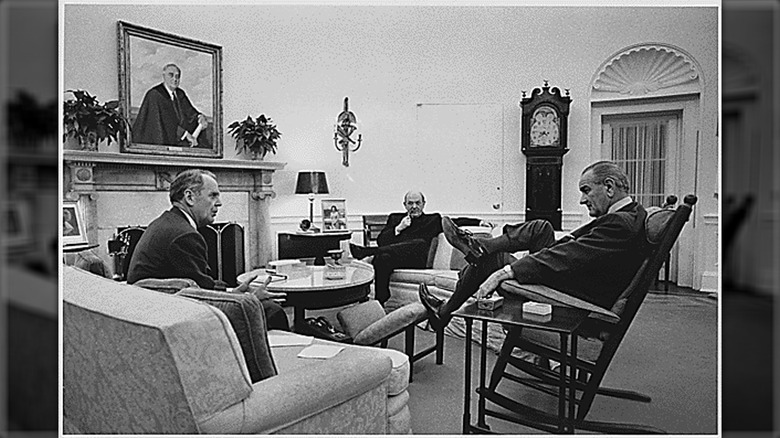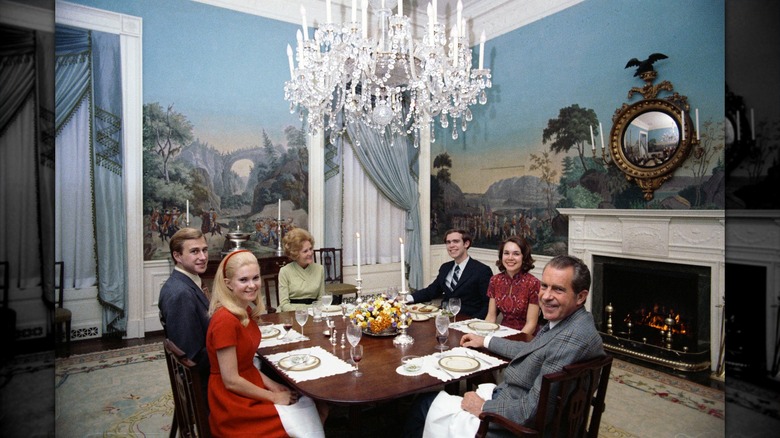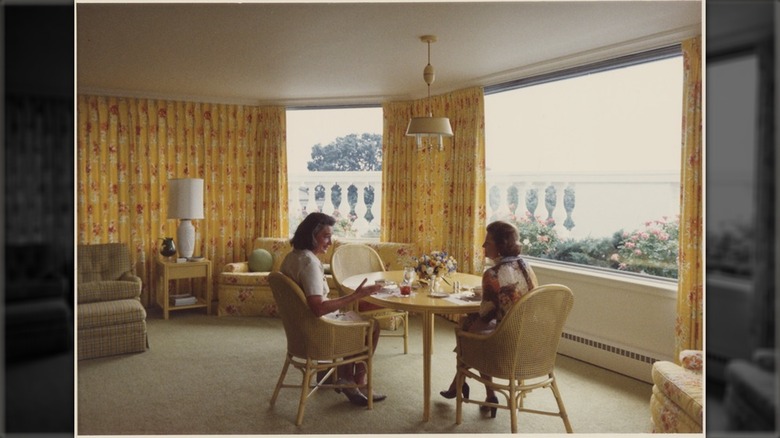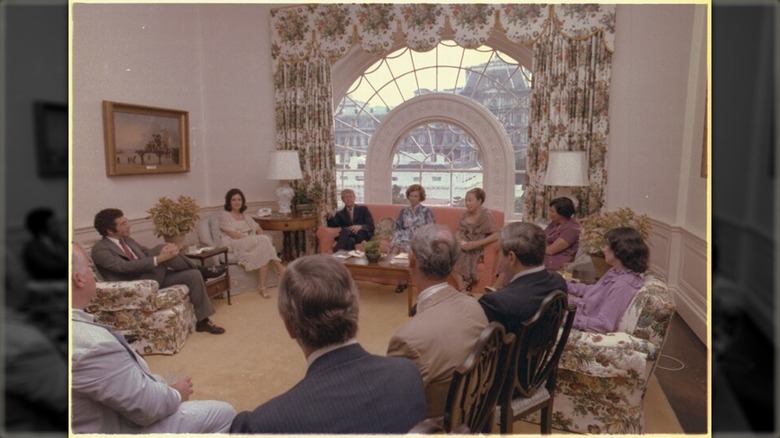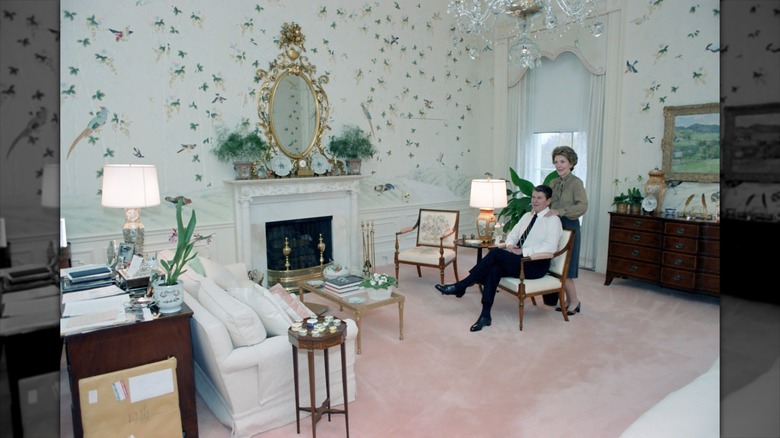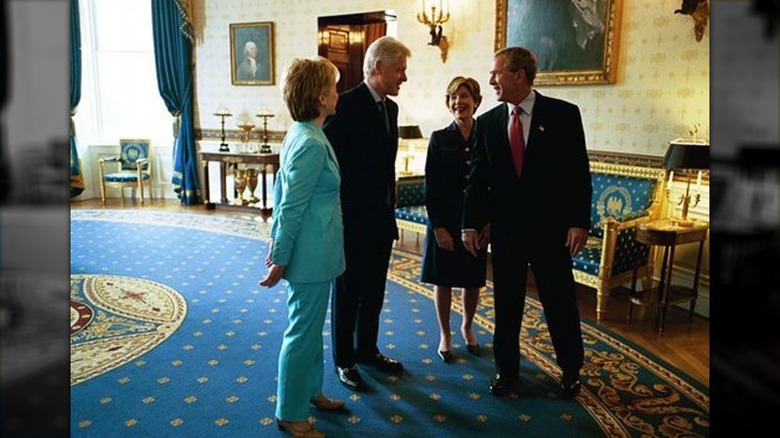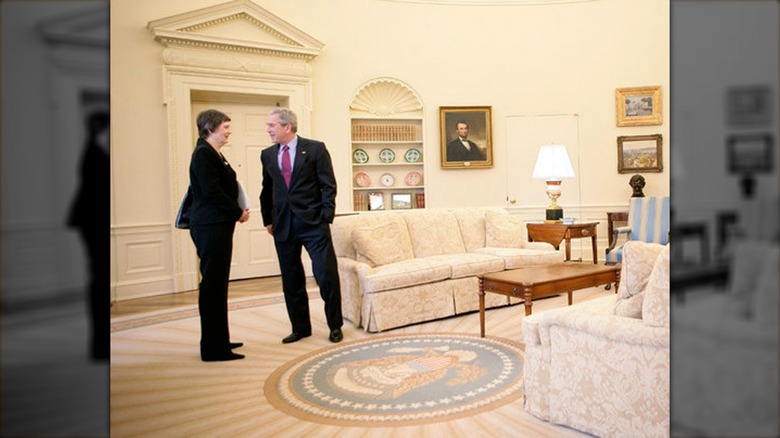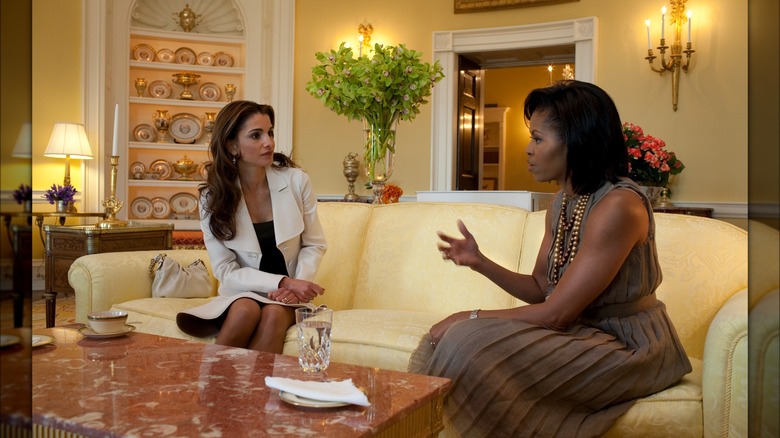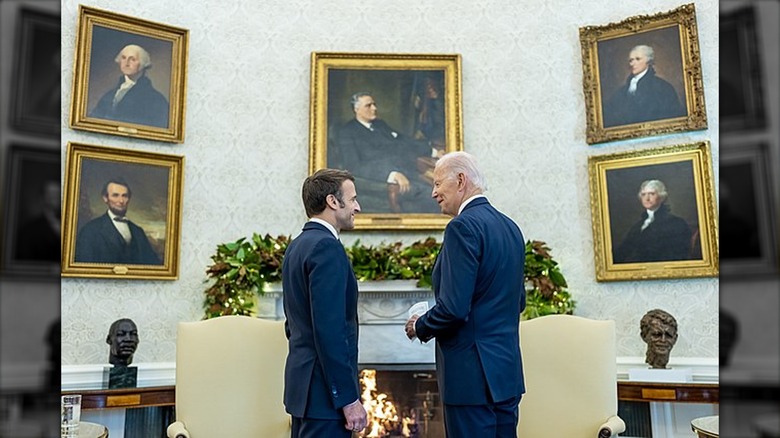The Most Iconic White House-Inspired Decor Ideas To Bring Into Your Home (& What To Avoid)
Possibly the most widely recognized building in our nation, the White House is a massive mansion featuring 132 rooms and 35 bathrooms over six floors. Every time a new president takes office, congress allocates some funds to repair, refresh, and redecorate the White House. The goal of this is to make the historical building feel more like home for the presidential family, who expects to spend at least four years there.
Of course, it's essential to preserve the history of the White House for future generations, so changes to some historical rooms and public visitor spaces must be approved by a committee. However, the presidential families are essentially given free rein in the president's private living quarters, including trading out items they don't want. These items end up in a massive storage building, which the presidential family can also "shop" from to decorate their new home. Traditionally, the president also decorates the Oval Office with artwork, portraits of their favorite past presidents, and a personalized presidential rug designed specifically for use during their term.
Who wouldn't want to feel like the king of the castle (or president of the nation) in their own home? By looking to past presidents for inspiration, you can bring home some regal and fascinating decorating ideas — and avoid some gossip-worthy design blunders. These are some of the most iconic ways presidential families have decorated the White House.
1. Arthur's Tiffany glass screen entrance
During his term in 1882, President Chester Arthur hired Louis Comfort Tiffany, the namesake behind Tiffany glass. In addition to decorating the Red Room, Blue Room, and East Room, Tiffany installed a one-of-a-kind stained glass screen in the White House entry hall. Because there was no color photography at the time, it's difficult to imagine just how beautiful the entry must have been. Unfortunately, the stained glass was later removed by President Theodore Roosevelt, who felt that the art deco design had become too dated by that time. You can copy the idea in your own home's entryway by adding art deco stained glass, faux stained glass window tint, or DIY faux stained glass.
2. Roosevelt's bold Red Room
In 1902, Theodore Roosevelt was responsible for overseeing the first-ever renovation of the White House. He kept in theme with the room's original names, coined as far back as 1845. Roosevelt's rendition of the Red Room featured bold oxblood red walls, which tied in beautifully with the red chairs and rich, warm-toned woods. Portraits were hung in thick gold frames that stood out against the dark red, as did the white trim around the doors and fireplace. Little did Roosevelt know, but these moody hues and gold tones would make a strong reappearance in the 2020s!
3. Truman's golden State Dining Room
President Truman and First Lady Bess Truman lived in the Blair House, also known as the "President's Guest House" for nearly the whole of Truman's first term. During that time, the White House underwent some serious renovations and refurbishments to bring it back to its Georgian architectural roots. The Trumans themselves seemed fond of gold, yellow, and bronze color schemes, perhaps most noticeable in the State Dining Room. The room's warm white and gold palette was intended to highlight and complement the intricate crown molding throughout the room, an idea that could also look gorgeous in a dining room today!
4. Kennedy's rose garden
Both John F. Kennedy and his wife, Jacqueline, wanted to preserve and restore the White House features and make the house accessible to the public as much as possible. After traveling, Kennedy suggested a beautiful rose garden like those he had seen in Europe. For help with the project, the First Lady connected with horticulturist Rachel Lambert Mellon, also known as "Bunny" Mellon. Together, they filled the garden with American plants arranged in a French style – an idea that could easily be replicated in your own home! Over time, other presidents added their own plants to the garden, and the iconic White House Rose Garden remained relatively untouched until it was redesigned in 2020.
5. Johnson's rockin' Oval Office
Lyndon B. Johnson didn't care much for pomp and grandeur, keeping his presidential color palette minimal, fresh, and just a little bit country. The Texas native and his wife, Lady Bird Johnson, appreciated comforting and traditional Americana décor throughout the White House. One perfect example is the rocking chair in LBJ's Oval Office, which Johnson decided to keep after it was actually left behind by former president John F. Kennedy. The Johnsons also spent a lot of time at their ranch house in Stonewall, Texas, humorously dubbed the "Texas White House."
6. Nixon's scenic President's Dining Room
The President's Dining Room is located above the main dining room, and prior to the Kennedy administration, this room was typically treated as a spare bedroom or family room. While the space had been turned into a dining room sometime before Nixon's term, First Lady Pat Nixon refurbished it and added a more modern carpet. The neoclassical fireplace, gorgeous wallpaper mural, and crystal chandelier should be enough to inspire anyone to create a dreamy blue dining room in their own home. If you look closely, you'll even see a hidden door to the left of the fireplace!
7. Ford's sunny yellow Solarium
Like the Trumans, the Ford family also seemed to have a penchant for yellow tones. The Solarium, an iconic room of the White House first built in 1927, can be seen here decked out with yellow drapes, sofas, and light yellow furniture. Yellow can be a divisive color when it comes to interior design, but the Fords struck a great balance between the soft patterned sofas and sleek wicker chairs that make the whole solarium feel like a sunny garden party. Notice the matching fabric of the sofa and drapes, a major trend of the time.
8. Carter's garden-like interiors
President Jimmy Carter and First Lady Rosalynn Carter were partial to relaxed yet traditional décor, reaching for comfortable furniture, nature-inspired patterns, and light, muted colors. Rooms decorated by the Carters featured lots of large-scale florals, greens, pinks, topiary, and touches of harvest gold set against a generally neutral background. The Carters' taste in interior design filled the White House residence with a sense of softness and Southern hospitality, perfect for entertaining guests with classical music and wine on a peaceful weekend.
9. Reagan's aviary-inspired bedroom
Fans of grandmillenial home design may appreciate Reagan's rendition of the White House rooms, filled with chintzy prints, refurbished antiques, and modern, pillowy sofas. Ronald and Nancy Reagan can be seen here in the first family's primary bedroom, decorated with pale colors and a unique bird-filled wallpaper. Of course, not everyone liked the dizzying patterns and overstuffed couches of the Reagans, including the Clintons' interior designer, Kaki Hockersmith, who ended up replacing the wallpaper.
10. Clinton's renovated Blue Room
The Clintons seemed partial to the color blue, adding a blue rug to the Oval Office and giving the Blue Room a bold new makeover. In 1995, they replaced the old, faded blue drapes and furnishings with shades of rich peacock blue and vibrant gold — a fresh but regal color combo for any home. Subtle details really shine through every corner of this room, from the lightly patterned wallpaper to the candelabra lamps and tasseled curtains. The room seems to be universally liked by the Presidential families, considering not much has changed since the Clintons refreshed the space.
11. Bush's lighthearted Oval Office
The layout of the Oval Office tends to stay the same over the years, but every president likes to add their own touches to the color scheme and general décor. President Bush stuck to warm, light neutrals and pastel tones in his Oval Office, with some of his favorite hues being blue, ivory, and gold. Whites and beiges were popular in interior design during the late 90s and early 2000s, and with neutrals making a major comeback in recent years, it makes sense to take some inspiration from this iconic White House era.
12. Obama's contemporary Yellow Oval Room
The Obamas added several contemporary touches to the White House, bringing the interior into a new era while still honoring its historical features. First Lady Michelle Obama wanted to see more postwar artwork brought into the collection, and many of these pieces were displayed in the Yellow Oval Room, a private parlor room often used by the family for relaxing, holding meetings, and greeting visitors. While they did hire a professional decorator, the Obamas did a great deal of their home shopping from stores like Crate & Barrel, Anthropologie, and Pottery Barn, showing that presidential style can also be accessible.
13. Trump's beautified bowling alley
Did you know that the White House houses a secret bowling alley? Added by President Richard Nixon in 1973, the underground bowling alley was remodeled by the Trumps in 2019. They installed new electrical wiring and bowling machines and added some modern, comfortable touches, including two lush velvet sofas, gold-framed artwork, and a few flatscreen TVs. While you may not have a bowling alley in your home, we love the idea of combining leisurely sports with luxury interior design. If you're feeling inspired, consider adding a seating nook or framed sporty artwork to your home gym!
14. Biden's inspirational artworks
Biden made some changes to the Oval Office following Trump's presidency, including swapping the beige rug for a deep blue rug and the reddish leather chair for a dark brown, tufted executive chair. Some of the most notable changes Biden made included artwork of several inspirational historical figures, including Martin Luther King Jr., Robert F. Kennedy, and Rosa Parks. If there are any historical figures you admire, consider following Biden's idea and framing their portrait in your home or adding a few biographical books to the coffee table.
